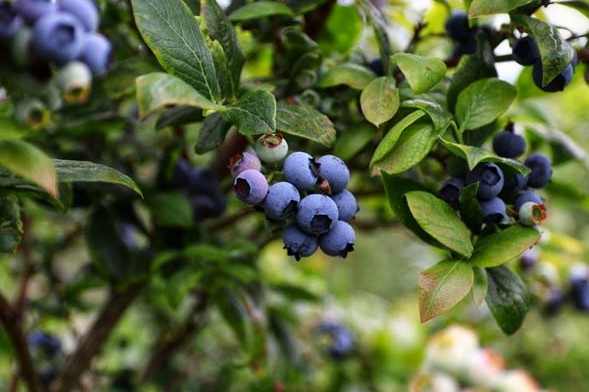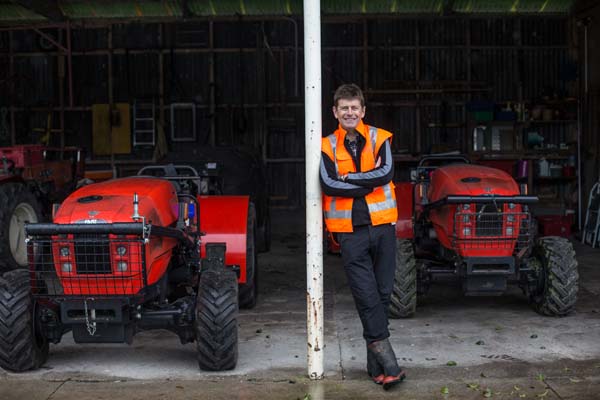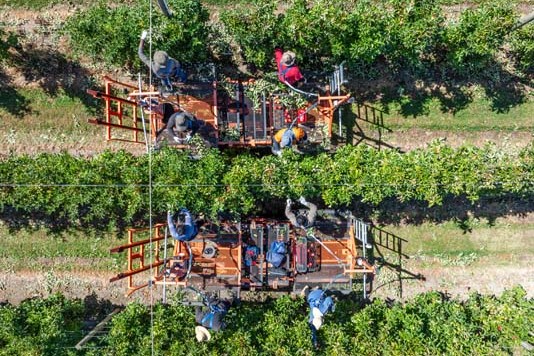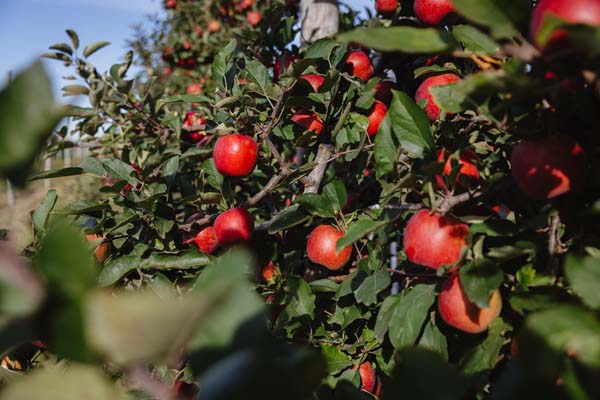Seeking sustainable profits
Discipline with budgets and not buying excess supplements, even in a high milk price season, is helping Waikato sharemilkers Brett and Emily Bradshaw repeat a sustainable profitable system year on year. Sheryl Haitana reports.

To chase production is vanity, to chase profit is sanity.” That is the best advice Brett and Emily Bradshaw received from Brett’s first employer Arthur Bryan.
The young couple have taken that philosophy onboard and stuck to low input and low cost pasture systems that are bringing in good profit and return on their assets. Brett and Emily have been sharemilking 235 Jerseys at Te Aroha for the past four seasons, averaging 1218kg milksolids (MS)/ha with just 200kg/cow supplement while also wintering the cows on.
Their average pasture and crop eaten is 15.2 tonnes and 15.4t for the past two seasons, well above the Matamata average of 13.5t and 14.4t respectively. That extra pasture growth and utilisation has flowed into operating profit. In 2021/22 with a milk price of $9.30 their operating profit was $2512/ha, almost $1000 more than the Waikato average of $1662/ha. In 2022/23 when the milk price dropped to $8.22, their operating profit was still superior, at $1596/ha above the Waikato’s $1244/ha. A key part of their success comes down to discipline around all of their decisions and keeping to budgets.
“I think we make a great team, we play to each other’s strengths. We know each other’s roles,” Emily says. “Brett is really good at thinking on that higher level thinking, looking at market trends and official cash rates, and I take care of the cash flow budgets and the details.”
Born in Hawke’s Bay, Brett became a plumber and worked in New Zealand for a few years before travelling to work in the Australian mines. A fellow Kiwi he met over in Australia gave him some farming aspirations from money he was making trading cattle back in NZ. When he returned home he decided to give dairy farming a crack and got a job in the Waikato through a friend he knew who was dairy farming. His first job was farm assistant for Aaron Mills, a contract milker for Arthur and Julie Bryan, milking 380 cows. That turned into an opportunity to manage Arthur and Julie’s 200-cow farm the following season where Brett says “he cut his teeth”. Having to work solo, there was nowhere to hide and he was pushed to upskill quickly.
“It was probably the best thing for me. I had overseeing help, but I did every single job.” Brett then had an opportunity to take on the contract milking position on Arthur’s 380-cow low-input farm which he was told if he could fully understand the system and build confidence in managing pasture with a relatively high stocking rate, it would open up other opportunities. Meanwhile, Emily came from a career as a social worker and then working in insurance. She has completed an agribusiness diploma through PrimaryITO since going sharemilking to upskill her knowledge and be across the financial side of the couple’s business. Emily keeps a careful oversight of all expenses, being across what payments are going out and what income is coming in.
“We avoid going into overdraft if we can. We are constantly looking at what is the best financial decision, what has the best pay off,” Emily says. Little things like Brett cutting the grass silage instead of the contractor is a good example of cutting costs where they can. They try not to invest a lot of money in machinery, purchasing second hand tractors etc. “You have to be on the same page, have discipline to control personal drawings and minimise debt as much as possible.”
Their farm working expenses have increased with inflation $1.63 to $2.08 last season. The system hasn’t changed but costs have gone up in those four years. When he built his herd, Brett aimed to buy 60% top cows and make the rest work.
He didn’t want to spend more money on cows than what the bank valued them at. While Brett was milking at Arthur’s they did an unofficial trial looking at the Jersey herd versus the crossbred herd. The Jerseys performed well and there wasn’t a lot of difference in production.
“In summer, Jerseys are out hunting for that last blade of grass, where crossbreds can be sheltering in the corner. Having Jerseys could limit us on some sharemilking jobs, but we love Jerseys,” Brett says. “If global warming is a thing, getting wetter winters and hot dry summers, my thinking is Jerseys are lighter in winter and handle the heat a bit better in summer.”
This year they have taken on a second sharemilking position, having placed a contract milker on their original farm and moving down the road to milk 460 Jerseys/Jersey crossbreds. They went for a contract milker on the Waghorn farm which costs them a little bit more than a manager, but theoretically they get a better operator and Brett is full time on their new farm so it’s more difficult to cover a manager’s time off. They have done an estimated budget for the new farm and hope to get it humming by putting on more urea strategically and utilising pasture grown. Timely use of urea and managing round speed are Brett’s two biggest tips to maximising pasture growth and utilisation. Stocking rate is also king, he says.
“Having enough cows to eat the grass so the grass is going into the vat and you’re not having to bale the surplus all the time.”
Their stocking rate at Waghorn is 3.6/ha and 3/ha at Rawhiti. After calving and balance date, Brett targets a 22-23 day round, he does regular farm walks every 10 days and projected feed wedges using Minda and he is constantly monitoring the weather and grass quality.
“I speed my round up if the opportunity is there, ideally getting extra grass in the vat, but if quality starts becoming an issue, paddocks are skipped and shut up for silage.
“I’m constantly working out what the farm is going to look like in two weeks time and making sure we have adequate feed on hand.
“I’m always on a 30-day round coming January 1 and milking OAD by the end of January and I hold that 30-day round until mid April. I start pushing out to my wintering round speed of 90 days come mid May.”
Brett puts on about 30-40kg of N to the hectare during winter through until September as needed.
“I like to get through calving until February without feeding anything out. I try to use the tractor only once a fortnight during calving to spread urea. I start following the cows with urea in June and July.”
Nitrogen is key in December, if you can get the window to apply it which helps push out round speed and pushes feed into January, Brett says.
They budget on using 130-160 units of nitrogen/hectare annually.
“We focus on maximising production pre Christmas, everything after that is up to the weather gods. “I have certain targets I aim for during the season; 330kgMS/ha by 1 October, 800-850kg MS/ha by 1 January.”
Using the DairyNZ Spring Rotation Planner is a non-negotiable when it comes to maximising production from pasture he says.
“Having the correct round speed is key, not going round too quickly. I try to get around 1500kg DM residuals. And I’ll send cows back into a paddock if they don’t hit that.”
He likes to start calving with a 2300kg DM cover and September 10 is usually balance date.
“The first year on Wagorn Road I didn’t push the system. The second year I hit balance date by 25 August.”
Brett tends to break the farm down into blocks for easy management and measures pasture every 10 days in winter and spring. This year with the season inconsistencies, they have been feeding out silage bales on both farms every day during spring.
“I’ve already spent a couple of grand on both tractors plus diesel costs. Emily’s given me a tune up for that.”
It’s a prime example of how increased supplement can add to overall costs, he says.
“The fuel budget has been blown out already from feeding out for two months.”
When the milk price peaked a couple of years ago, Brett considered buying more supplement to make more milk, but ultimately decided it wasn’t worth it.
“There was a dollar in it, but the Waghorn farm is not set up for supplement. The only storage for palm kernel is the calf sheds, which I can’t use during the winter months.”
Feeding out is also extra labour and using trailers can make a mess of the paddocks and wastage. As a sharemilker you always have to nail the owner’s brief, on how they want the farm to be run, he says. Substituting grass with feed and leaving grass behind is also a big red flag for Brett. He doesn’t mind using supplement during summer and autumn when there is less risk of substitution.
The couple have two children, Briar, 4, and Patrick, 1, and family is the main driver, Brett says.
“If they don’t have to work as hard as I have, that gets me out there, and to give us options down the track.”
The pathway through the industry felt slow but their equity growth has increased quickly since going sharemilking. But their success is not luck. It’s the result of a lot of sacrifice and hard work.
“There are days we have been out in the paddock and the rain has been coming in sideways, it’s not luck, it’s been really hard work.”
They are planning on putting all their cards on the table in a couple of years when Brett turns 40 and deciding where they go next. House ownership is a goal, and land ownership, whether that is a farm or not they have not decided. They want to be in a position where they can live comfortably and be able to spend time with the children and go watch them play sport on the weekend.





